
ST EDMUND THE KING, NORTHWOOD HILLS ARCHIVE SEP 2005-AUG 2006
The articles below are taken from my monthly columns in St Edmund's Church parish magazine ("The King"), which includes full details of my organ voluntaries for that month.
FROM THE CONSOLE - AUGUST 2006
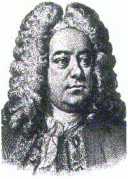
Click to enlarge
I am continuing my countdown of the nation's favourite hymns as surveyed by "Songs of Praise".
No.13 - Thine Be The Glory (Click to listen)
The tune originates from George Frederick Handel's oratorio "Judas Maccacbeus" to the words "See the Conquering Hero Comes". It was first performed at Covent Garden in 1747 with the libretto by Thomas Morrell based on the apocryphal First book of Maccabees. Handel (pictured above) composed the score as a tribute to the Duke of Cumberland who led government forces to victory over the heavily outnumbered Jacobites at Culloden. In 1884, Edmond Budry, pastor of the Swiss town of Vevey, wrote an Easter hymn to Handel's tune which begins "A Toi La Gloire". These French words were translated into English in 1923 by Richard Hoyle. The tune has been used by the BBC (in an arrangement by Carl Davis) as their 2006 World Cup theme tune (you can hear it here) because, according to the BBC, "we wanted to use music by Handel, because as a composer who was born in Germany, but spent most of his adult life in England, he seemed the most appropriate for the World Cup in Germany."
No.12 - O Love That Wilt Not Let Me Go (Click to listen)
George Matheson was born in Glasgow in 1842. He began to lose his sight before he was a year old and was completely blind by the age of 20. He graduated from Glasgow University before becoming ordained as a Church of Scotland minister. Due to his ability to memorize sermons and entire sections of the Bible, listeners were often unaware he was blind. Matheson's words to this hymn first appeared in the Church of Scotland magazine Life and Work in 1882. They were written very quickly in the space of a few minutes and were not revised afterwards. Albert Pearce was born in Huddersfield and at the age of nine was appointed organist at Holmfirth Parish Church (setting for BBC's "Last of the Summer Wine"). He was later organist at Glasgow Cathedral. Like the words, the tune to this hymn was written very rapidly ("the ink of the first note was hardly dry when I had finished the tune."). It was written in 1884 on the Scottish island of Arran. He called the tune "St Margaret" after the great Scottish queen who is of course so familiar to me!
.
Aug 27th
Prelude - Canon in D - J.Pachelbel (1653-1707)
Postlude - Prelude in B Minor - J.S.Bach (1685-1750)
FROM THE CONSOLE - JULY 2006
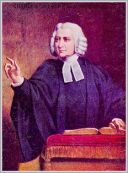
Click to enlarge
I am continuing my countdown of the nation's favourite hymns as surveyed by "Songs of Praise".
No.15 - Great Is Thy Faithfulness (Click to listen)
The words were written by Thomas Chisholm, who was born in Kentucky in 1866. He was briefly a Methodist minister, although he was forced to resign after just a few years through ill health. During his long life he had a number of jobs including teacher, newspaper editor and insurance salesman. Chisholm wrote over 1200 poems, of which 800 were published, and many have been set to music. He died in New Jersey in 1960 and is buried in Pennsylvania. The music was written by William Runyan. Born in New York in 1870, he was, like Chisholm, a Methodist minister. By the age of twelve he was serving as a church organist. He wrote the music to this hymn in 1923 and included it in the hymnbook "Songs of Salvation and Service" which he was compiling at the time. Runyan died in Kansas in 1957.
No.14 - And Can It Be (Click to listen)
The words were written by Charles Wesley (pictured above). He was born the son of a Rector in 1707. He studied at Oxford University, where he founded the Oxford Methodist group and became a leader in Methodist movement along with his elder brother John. Charles wrote over 6000 hymns, many of which are still popular. These include "Hark the Herald Angels Sing", "Rejoice the Lord is King" and "Love Divine, All Loves Excelling". "And Can It Be" first appeared in the publication "Psalms and Hymns" of 1738. Charles' grandson, Samuel Sebastian Wesley, held a number of cathedral organist posts and was also the composer of such anthems as "Lead Me Lord", which can often be heard at St Edmund's. The music of "And Can It Be" was written by Thomas Campbell, the son of an Argyllshire tobacco trader. He had a life-long interest in education and was instrumental in the founding of University College London in 1826 and was also Rector of Glasgow University from 1826 to 1829. He died in Boulogne in 1877 and is buried in Westminster Abbey. The tune to this hymn first appeared in "Bouquet", an 1825 collection of 23 hymn tunes edited by Campell.
July 2nd
Prelude - Choral - Louis Vierne (1870-1937)
Postlude - Hallelujah Chorus - G.F.Handel (1685-1759)
July 9th
Prelude - Lied - Louis Vierne
Postlude - Hornpipe ("Water Music") - G.F.Handel
July 16th
Prelude - Berceuse - Louis Vierne
Postlude - Postlude on "Hyfrodol" - H.Coleman
July 23rd
Prelude - Berceuse - E.Tomlinson (b.1924)
Postlude - Trio Sonata No 1 (1st Move) - J.S.Bach (1685-1750)
July 30th
Prelude - Andante - A.Scriabin (1872-1915)
Postlude - Voluntary No 6 - M.Greene (1696-1755)
FROM THE CONSOLE - JUNE 2006
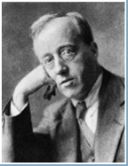
Click to enlarge
I am continuing my countdown of the nation's favourite hymns as surveyed by "Songs of Praise".
No.17 - I Vow To Thee My Country (Click to listen)
Cecil Spring-Rice was born in 1859 and was educated at Eton and Balliol College, Oxford. He was a diplomat by profession and became Ambassador to the United States in 1912 where he was influential in persuading the Americans to join the First World War. The text for "I Vow To Thee" was written in 1918 shortly after Spring-Rice was relieved of his ambassadorial duties and was subsequently retired. He died later that year in the Canadian city of Ottawa.
The music was written by Gustav Holst (pictured above), being the central theme of the fourth movement ("Jupiter") of "The Planets" suite, first performed in 1920. Holst's own daughter was at St Paul's School with Cecil Spring-Rice's daughter and it is thought that they persuaded Gustav to set these words to "Jupiter" in 1925. Holst himself was Director of Music at the school for many years.
The hymn was a favourite of the late Princess of Wales, and was sung at both her wedding and her funeral.
I wrote about Gustav Holst in more detail in my magazine column of December 2003 as the composer of "In the Bleak Midwinter" and this article can still be found online here.
No.16 - What A Friend We Have In Jesus (Click to listen)
The words to this hymn were written by Joseph Scriven. He was born in Ireland in 1819 and graduated from Trinity College, Dublin. Sadly his fiancée was killed the day before their wedding and he subsequently emigrated to Canada. Another tragedy was said to have inspired the writing of this hymn. In 1854, his second fiancée, Eliza Roche, fell ill shortly before their wedding and died after a three year battle. The words were written to comfort his mother still in Ireland who mourned her son's unhappiness. The hymn was not discovered until just before Scriven's death in 1886 when a friend was looking through some of writer's papers. When asked how he came to write such a beautiful hymn, Scriven, on his deathbed, replied simply 'The Lord and I did it between us'.
The music was written in 1868 by Charles Converse. Born in Massachusetts in 1834, Converse studied in the German city of Leipzig where he enjoyed the friendship of Franz Liszt. He returned home in 1857 and graduated from the Albany Law School in 1861. He spent much of his subsequent professional life as a lawyer in Erie, Pennsylvania. He died in 1918 and is buried in Canandaigua, New York.
May 7th
Prelude - Après Un Rêve - G.Fauré (1845-1924)
Postlude - Final & Marche - L.Boellmann (1862-1897)
May 14th
Prelude - Sheep May Safely Graze - J.S.Bach (1685-1750)
Postlude - Organ Concerto - G.F.Handel (1685-1759)
May 21st
Prelude - Prelude on "Rhosymedre" - R.Vaughan Williams (1872-1958)
Postlude - Prelude on "Hyfrydol" - R.Vaughan Williams
May 28th
Prelude - Prière du Christ Montant Vers Son Père (L'Ascension) - O.Messiaen (1908-1992)
Postlude - Trio Sonata No 5 (1st movement) BWV 529 - J.S.Bach (1685-1750)
Jun 4th
Prelude - Chanson de Matin - E.Elgar (1857-1934)
Postlude - Voluntary - William Boyce (1711-1779)
Jun 11th
Prelude - Aria - Flor Peeters (1903-1986)
Postlude - Praise The Lord O My Soul - S.Karg-Elert (1877-1933)
Jun 18th
Prelude - Sonata No 4 (3rd Movement) - F.Mendelssohn (1809-1847)
Postlude - Sonata No 4 (4th Movement) - F.Mendelssohn
Jun 25th
Prelude - Air and Gavotte - S.S.Wesley (1810-1876)
Postlude - Prelude No 4 - Franz Schmidt (1874-1939)
FROM THE CONSOLE - APRIL 2006
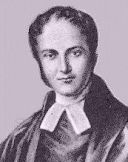
Click to enlarge
At the end of last year, the BBC programme "Songs Of Praise" carried out a survey of the nation's favourite hymns and produced a list of the top twenty. Over the next few months I shall write about these hymns and provide an internet audio link for each.
No.20 - Amazing Grace (Click to listen)
I wrote about the history of "Amazing Grace" in last November's magazine (see below).
No.19 - Praise My Soul The King Of Heaven (Click to listen)
No.18 - Abide With Me (Click to listen)
The words to both of these hymns were written by the same man. Henry Francis Lyte (pictured above) was born near Kelso in the Scottish Borders in 1793. His father was a naval officer and the family moved to Ireland. Lyte was orphaned at an early age and went on to study at Trinity College, Dublin, where he excelled in poetry. He was ordained and served in a number of parishes in Ireland and Western England, most notably All Saints, Lower Brixham in Devon where he spent the last twenty-three years of his life. He suffered poor health and spent the winters in the warmer climes of Italy. It was on his way to Rome that he was taken ill and died in Nice in 1847.
"Praise My Soul The King Of Heaven" was first published in 1834 and is based on Psalm 103. The music was written by Sir John Goss. Goss was born in Hampshire in 1800 and studied with Thomas Attwood, whom he succeeded as organist at St Paul's Cathedral in 1838. He was also Professor of Harmony at the Royal Academy of Music for almost fifty years and was knighted in 1872. As well as this hymn, Goss wrote the music for "See Amid The Winter's Snow".
Lyte wrote "Abide with Me" shortly before his final departure for Europe and also wrote his own tune. The text for the hymn is based on Christ's appearance to the disciples on the road to Emmaus - "Abide with us, for it is toward evening and the day is far spent" (Luke 24:29). The words was discovered by William Henry Monk (1823-1889), the first music editor of "Hymns Ancient and Modern", who is said to have written his own more well-known tune to "Abide with Me" for the hymnal in less than half an hour. Monk was also choir director and organist of King's College, London and organist of St.Matthias in Stoke Newington.
Apr 2nd
Prelude - O Mensch, bewein' dein' Sunde gross - J.S.Bach (1685-1750)
Postlude - Fugue No.1 on BACH - R.Schumann (1810-1856)
Apr 9th
Postlude - Fugue (BWV 654) - J.S.Bach
Apr 16th
Prelude - A Resurrection Prelude - James Patten (b.1936)
Postlude - Chorale Prelude on Nun Danket - Siegfried Karg-Elert (1877-1933)
Apr 23rd
Prelude - Nun Sei Willkommen Jesus Lieber Herr - Flor Peeters (1903-1986)
Postlude - Prelude and Fugue in D Minor - D.Buxtehude (1637-1707)
Apr 30th
Prelude - Salix - Percy Whitlock (1903-1946)
Postlude - Grand March (Aida) - G.Verdi (1813-1901)
FROM THE CONSOLE - MARCH 2006
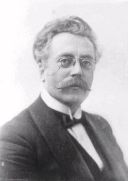
Click to enlarge
Mar 5th
Prelude - Minuet - G.F.Handel (1685-1759)
Postlude - Hornpipe - G.F.Handel
Mar 12th
Prelude - Allegretto Grazioso - F.Bridge (1879-1941, pictured above)
Postlude - Allegro Marziale - F.Bridge
Mar 19th
Prelude - Three Pieces For Musical Clocks - J.Haydn (1732-1809)
Postlude - Solemn Processional March - M.Setchell
Mar 26th
Prelude - On Hearing The First Cuckoo In Spring - F.Delius (1862-1934)
Postlude - Toccata - G.Mushel (1909-1989)
FROM THE CONSOLE - FEBRUARY 2006
Here is the solution to last month's crossword:
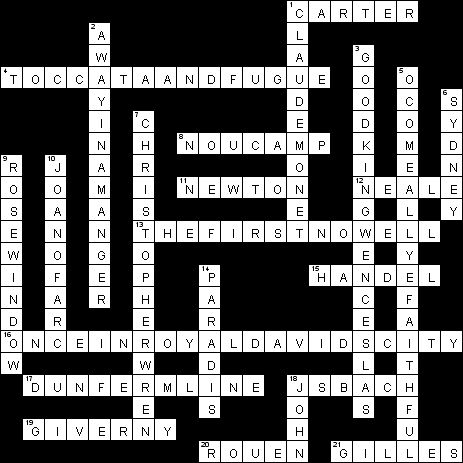
Born in Rome around 1545, Giulio Caccini's most famous composition - "Ave Maria" - was virtually unknown until about ten years ago when it was recorded by the Latvian soprano Inessa Galante. Galante heard the work while on tour and had it transcribed by a fellow musician (much in the same way that the young Mozart is said to have memorised and then transcribed Allegri's "Miserere" while at St Peter's Rome in 1769). Galante's 1994 recording was the inspiration for Lesley Garrett to record the work (and later Charlotte Church and Andrea Bocelli) and has subsequently become one of the most requested pieces on Classic FM. Caccini was a member of the Camerata, a group of nobles and musicians who met to discuss science, drama and music, and was particularly involved in the attempts to add music to ancient Greek drama, which led to Opera. Caccini's "Euridice" of 1600 was generally regarded as the first opera ever written. There is a certain amount of conjecture as to the authenticy of "Ave Maria", particularly the harmony. Judge for yourself on February 5th and here.
Feb 5th
Prelude - Ave Maria - G.Caccini (1545-1618)
Postlude - Prelude and Fugue No 5 (BWV 557) - J.S.Bach (1685-1750)
Feb 12th
Prelude - Interlude -J.Langlais (1907-1991)
Postlude - Prelude and Fugue No 2 (BWV 558) - J.S.Bach
Feb 19th
Prelude - Chanson de Matin - E.Elgar (1857-1934)
Postlude - Prelude and Fugue No 3 (BWV 559) - J.S.Bach
Feb 26th
Prelude - Es Ist Ein' Ros' Entsprungen - J.Brahms (1833-1897)
Postlude - Prelude and Fugue No 4 (BWV 560) - J.S.Bach
FROM THE CONSOLE - JANUARY 2006
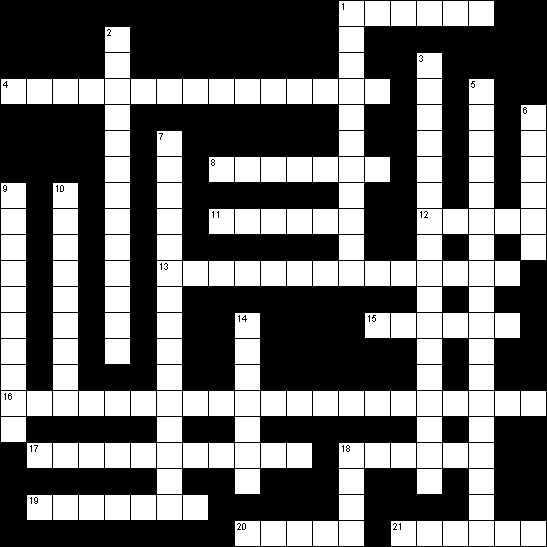
Here is my annual crossword with clues taken from my columns over the last twelve months. Some of the clues are straightforward while others are a little more cryptic. In addition there are four well-known mystery carols to insert. Answers in the February magazine.
Across
1 See 6 Down
4 Piece composed by 18 Across (7,3,5)
8 Famous Spanish football stadium (3,4)
11 See 18 Down
12 John Mason ---, writer of 3 Down (5)
13 MYSTERY CAROL (3,5,6)
15 Held an altered Watery composer (6)
16 MYSTERY CAROL (4,2,5,6,4)
17 Fieldmen run around Queen Margaret's Scottish resting place (11)
18 German baroque composer (1,1,4)
19 Home of 1 Down (7)
20 City in Normandy (5)
21 Is Virgil Leslie my wife's patron saint? (6)
Down
1 Rearranged Coleman duet makes impression (6,5)
2 MYSTERY CAROL (4,2,1,6)
3 I acknowledge songs around philanthropic royalty (4,4,9)
5 MYSTERY CAROL (1,4,3,2,8)
6 and 1 across - Writer of such hymns as Lord of the Dance (6,6)
7 Throw Princes her twisted Greenwich Naval College architect (11,4)
9 Weirdo owns twisted feature of Northern Minster (4,6)
10 Saint who was burnt at 20 Across (4,2,3)
14 She's almost a heavenly composer! (7)
18 and 11 across - Writer of such hymns as Amazing Grace (4,6)
Jan 8th
Prelude - Chorale Prelude on "Stuttgart" - Flor Peeters (1903-1986)
Postlude - Prelude and Fugue No 1 (BWV 553) - J.S.Bach (1685-1750)
January 15th
Prelude - Chorale Prelude on "Dix" - Malcolm Archer
Postlude - Prelude and Fugue No 2 (BWV 554) - J.S.Bach
Jan 22nd
Prelude - Adagio (Symphony No 3) - C.Saint-Saens (1835-1921)
Postlude - Prelude and Fugue No 3 (BWV 555) - J.S.Bach
Jan 30th
Prelude - Pastorale - J.Lubbock
Postlude - Prelude and Fugue No 4 (BWV 556) - J.S.Bach
FROM THE CONSOLE - DECEMBER 2005
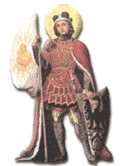
Click to enlarge
Wenceslas was a 10th Century Duke of Bohemia and did much to encourage Christianity in Central Europe against his heathen mother's wishes. He was martyred by his younger brother Boleslav, at the urging of their mother. Wenceslas' faith was immortalised in the legend of Good King Wenceslas and incorporated into many literary collections.
One man who came across this legend was John Mason Neale, 19th Century Clergyman, Historian and Hymn Writer. He studied at Trinity College, Cambridge and was ordained to the priesthood in 1842. For the last twenty years of his life, Neale was warden at Sackville College, East Grinstead, a charitable institution for the poor. He also co-founded the Sisterhood of St Margaret, an organisation dedicated to nursing the sick.
As early as 1850, Neale had included the Wenceslas legend as one of the fifteen stories in his "Deeds of Faith - Stories for Children from Church History", stating that "their only design is to lead children to take an interest in ecclesiastical history". Two years later he wrote the poem we know today as "Good King Wenceslas". The tune was taken from a 16th Century Scandinavian song collection called "Piae Cantiones" ("Devout Songs") and was originally sung to the words "Tempus Adest Floridum" ("Spring Has Unwrapped Her Flowers"). This song collection contains the origins of several other famous Christmas carols including In Dulci Jubilo, Unto Us a Boy Is Born and Of the Father's Heart Begotten. You can hear a version of the carol by clicking here
Before the Service of Nine Lessons and Carols on December 18th, I shall be performing J.S.Bach's Toccata and Fugue in D Minor as part of Radio 3's "A Bach Christmas". Between December 16th and 25th the channel will be broadcasting the complete works of the great composer. The "Toccata and Fugue" celebration aims to get as many organists as possible to perform the work on that day. Details of my performance as well as others in the London area can be found on the Radio 3 Website
May I take this opportunity to wish all of you a merry Christmas and a happy new year. My e-mail address is organist@saintedmundschurch.org.uk. If you have any comments or questions I would be very pleased to hear from you.
.
Dec 4th
Prelude - Advent Reflections - R.Bonighton (1946-)
Postlude - Carillon - L.Vierne (1870-1937)
Dec 11th
Prelude - Andantino - Edwin Lemare (1865-1934)
Postlude - Fantasia on "Helmsley" - Alan Ridout (1934-1996)
Dec 18th (10.00am)
Prelude - Desseins Eternals - O.Messiaen (1908-1992)
Postlude - O Come, O Come Emmanuel - Gordon Phillips
Dec 18th (6.30pm)
Prelude - Toccata and Fugue in D Minor BWV 565 - J.S.Bach (1685-1750)
Postlude - In Dulci Jubilo - J.S.Bach & Toccata (Symphonie No.5) - C.Widor (1844-1937)
FROM THE CONSOLE - NOVEMBER 2005
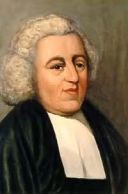
Click to enlarge
Amazing grace! How sweet the sound
That saved a wretch like me!
I once was lost, but now am found;
Was blind, but now I see.
John Newton was born in Wapping on July 24th 1725. He was the son of a merchant ship commander and went to sea with his father at the age of eleven. At the age of nineteen he was press ganged into service on the H.M.S Harwich. Finding conditions on board intolerable, he deserted and was publicly flogged when recaptured. He exchanged service onto a slave ship and eventually became the captain of his own vessel.
On one particular voyage in 1748, his ship was struck by a terrible storm. Thinking that the ship would surely sink, he wrote in his journal "Lord have mercy on us". Later in his cabin he reflected on what had happened and came to believe that God had saved them.
Over the next six years his faith matured. In 1755 he gave up the slave trade and became surveyor of tides at Liverpool where he met George Whitefield, leader of the Calvinistic Methodist Church. Later he met John Wesley and in 1764 was ordained as a Church of England priest, taking up the curacy at Olney near Milton Keynes.
He became good friends with the poet William Cowper and between them they published Olney Hymns which featured 280 of Newton's hymns, including "Amazing Grace" (there is a museum in Olney dedicated to the lives of these two men). In 1779 he became Rector at St Mary, Woolnoth in the City of London where he remained until his death on December 21st 1807. Newton and his wife were originally buried at St Mary's but were reinterred at Olney in 1893.
The melody of "Amazing Grace" first appears in an 1831 hymnal called "Virginia Harmony", although it is believed to be Irish or Scottish in origin. The tune itself is pentatonic - a five-note scale which means the entire melody can be played on just the black notes of the piano.
As well as "Amazing Grace", Newton wrote the words of such hymns as "Glorious Things Of Thee Are Spoken" and "How Sweet The Name Of Jesus Sounds"
Nov 6th
Prelude - Chorale - William Matthias (1934-1992)
Postlude - Processional - William Matthias
Nov 13th (10.00am)
Prelude - Nimrod - Edward Elgar (1857-1934)
Postlude - Fame and Glory - Albert Matt
Nov 13th (3.30pm)
Prelude - Pavane - Gabriel Faure (1845-1924)
Postlude - Sicilienne - Maria Theresia von Paradis (1759-1824)
Nov 20th
Prelude - Concerto No 2 in A Minor (BWV 593) - Second Movement - J.S.Bach (1685-1750)
Postlude - Concerto No 2 in A Minor (BWV 593) - First Movement - J.S.Bach
Nov 27th
Prelude - O Come, O Come Emmanuel - C.Hand (1929- )
Postlude - Wachet auf, ruft uns die Stimme (BWV645) - J.S.Bach
FROM THE CONSOLE - OCTOBER 2005

Click to enlarge
At the end of August we spent a few days in Rouen in Northern France. Victor Hugo described it as "the city of a hundred spires". Much of Rouen was destroyed during World War Two and the old quarter has been largely reconstructed. One of the most impressive churches in Rouen is Saint Ouen. The organ dates from 1890 and was the last instrument built by the famous French builder Aristide Cavaille-Coll.
The city is rich in history and both William the Conqueror and Joan of Arc died there. Saint Jeanne d'Arc was born in Eastern France around 1412. Three years later Henry V won the Battle of Agincourt and England gained control of much of Northern France with Henry himself becoming Heir to the French throne. Around 1424 Jeanne began to hear the voices of Saints Catherine, Margaret and Michael telling her to lead the French army against the English invaders. Four years later Jeanne decided to act and, dressed as a man, she helped to recapture the besieged city of Orleans. She then led the overthrown dauphin Charles to Reims where he was crowned King of France. Betrayed by the French, Jeanne was sold to the English who had her tried for witchcraft and heresy. She was condemned and burnt at the stake in Rouen on May 30th 1431. She was just nineteen years of age. The picture shows the cross in the Place du vieux marché which marked the place of her death. The building in front is the Joan of Arc church, built in 1979. The church has some beautiful sixteenth century stained glass windows which were rescued from a church destroyed in 1944.
We also spent a delightful day at Giverny, home of the painter Claude Monet. This was particularly special for Alex as his class this year is called Monet!
The series on hymn-writers will continue next month.
Oct 2nd
Prelude - Lyric Melody - Armstrong Gibbs (1889-1960)
Postlude - Jubilate - Armstrong Gibbs
Oct 9th
Prelude - Promenade Sentimentale - V.Cosma (b.1940)
Postlude - Prelude and Fugue in D - D.Buxtehude (1637-1707)
Oct 16th
Prelude - Largo, Allegro and Aria - M.Festing (1705-1752)
Postlude - Tuba Tune - N.Cocker (1889-1953)
Oct 23th
Prelude - Hymne - J.Canteloube (1879-1957)
Postlude - Overture ("Messiah") - G.F.Handel (1685-1759)
Oct 30th
Prelude - Rhapsody No 1 - H.Howells (1892-1983)
Postlude - Andante Con Moto - F.Bridge (1879-1941)
FROM THE CONSOLE - SEPTEMBER 2005

Click to enlarge
"Dance then wherever you may be
I am the Lord of the Dance"
This month I am starting a series of articles on hymn writers, starting with the man who was responsible for arguably the most celebrated hymn of the twentieth century.
Sydney Carter was born in Camden Town on May 6th 1915. He studied at Christ's Hospital in Horsham and went on to read Modern History at Balliol College, Oxford. After graduating, Carter taught at Frensham Heights in Surrey until the outbreak of the Second World War. A strong pacifist, he joined the Quaker's Ambulance Unit and served in Palestine, Jordan, Egypt and Greece. It was in Greece that he had his first encounter with the folk music that would influence his subsequent writing. After the war Carter worked for the British Council and broadcasted on the World Service. He also had a career as a poet and folk singer and was particularly noted for working with Donald Swann.
"Lord of The Dance" was written in 1963. The tune is an adaptation of the Shaker tune "Simple Gifts" and was used in Copland's ballet "Appalachian Spring". The song was also the inspiration for Michael Flatley's phenomenal Irish dance show which is still touring worldwide and is due to come to London this Christmas.
As well as "Lord of the Dance", two of Sydney Carter's other hymns are in the top ten modern school hymns according to a recent survey by Christian Copyright Licensing International - "One More Step" was top while "When I needed a neighbour" was 7th. Lord of the Dance itself was 4th.
Sydney Carter died on March 13th 2004 aged 88. Thirty years earlier he had written his own epitaph: "Dancing is all that I can ever trust, the dance is all I am, the rest is dust. I will believe my bones and live by what will go on dancing, when my bones are not."
Sep 4th
Prelude - Canon in D - J.Pachelbel (1653-1707)
Postlude - Prelude in B Minor - J.S.Bach (1685-1750)
Sep 11th
Prelude - Ave Maria - G.Caccini (1545-1618)
Postlude - Grand Coeur in D - A.Guilmant (1837-1911)
Sep 18th
Prelude - Choral (24 Pieces) - L.Vierne (1870-1937)
Postlude - Arrival of the Queen of Sheba - George Handel (1695-1759)
Sep 25th
Prelude - Lied (24 Pieces) - L.Vierne
Postlude - Praise The Lord O My Soul - S.Karg-Elert (1877-1933)


















